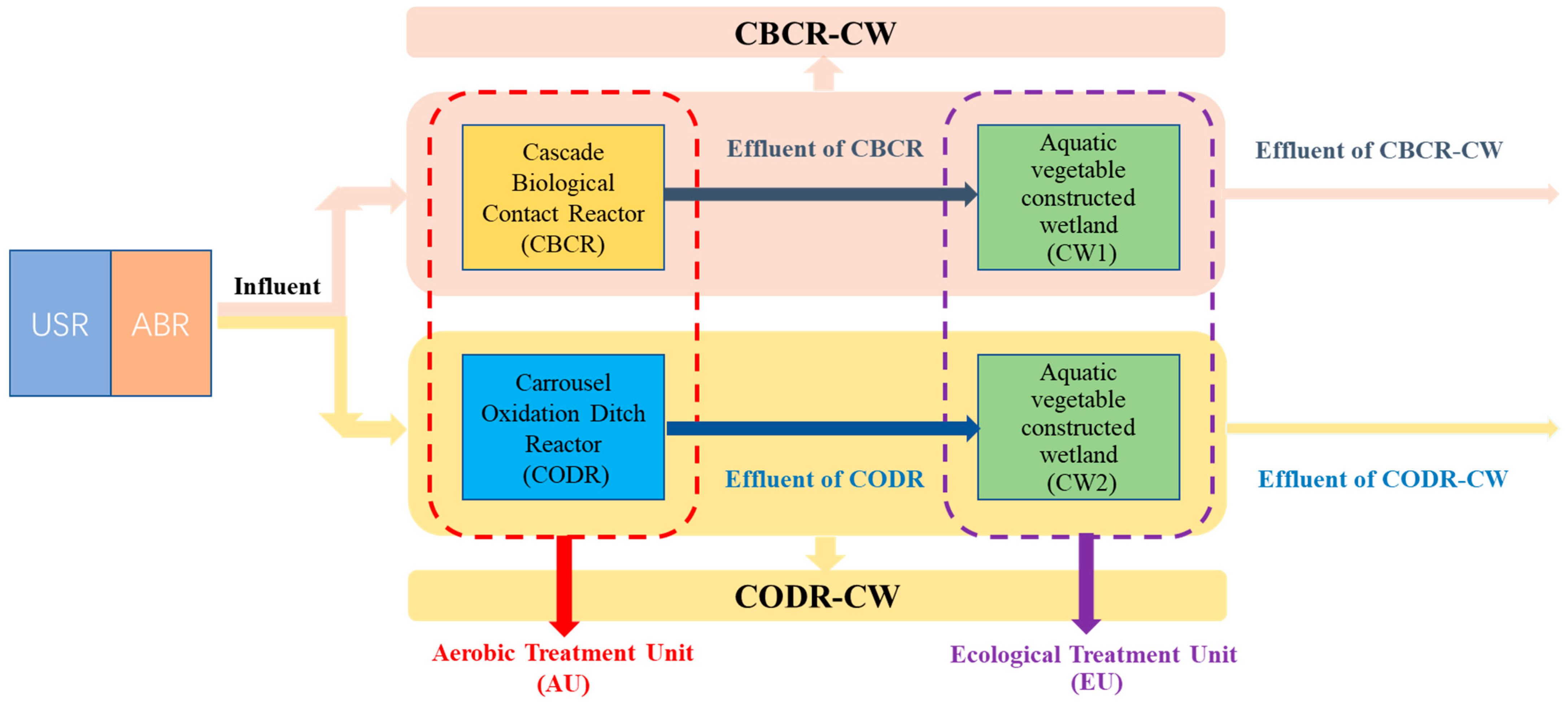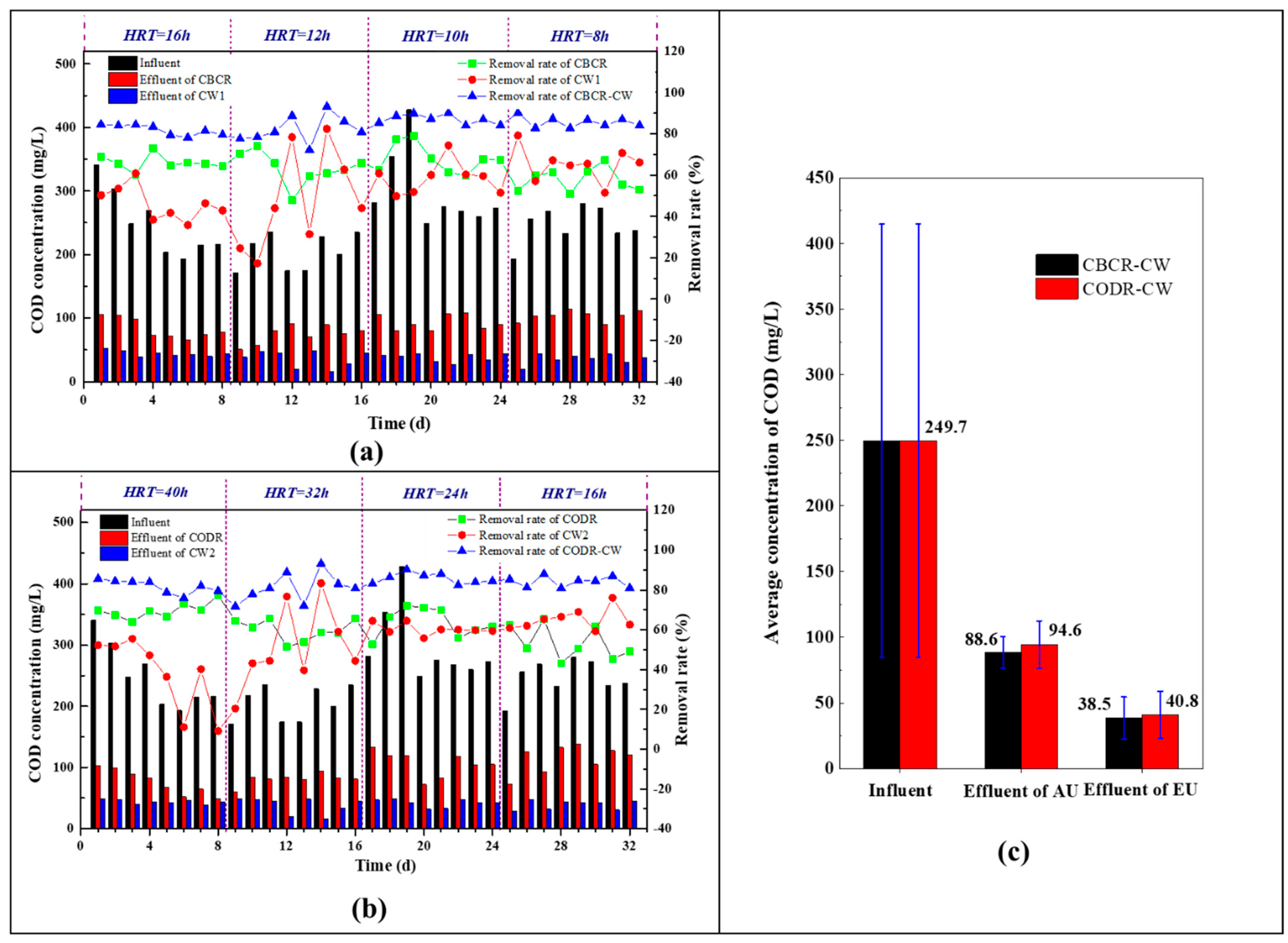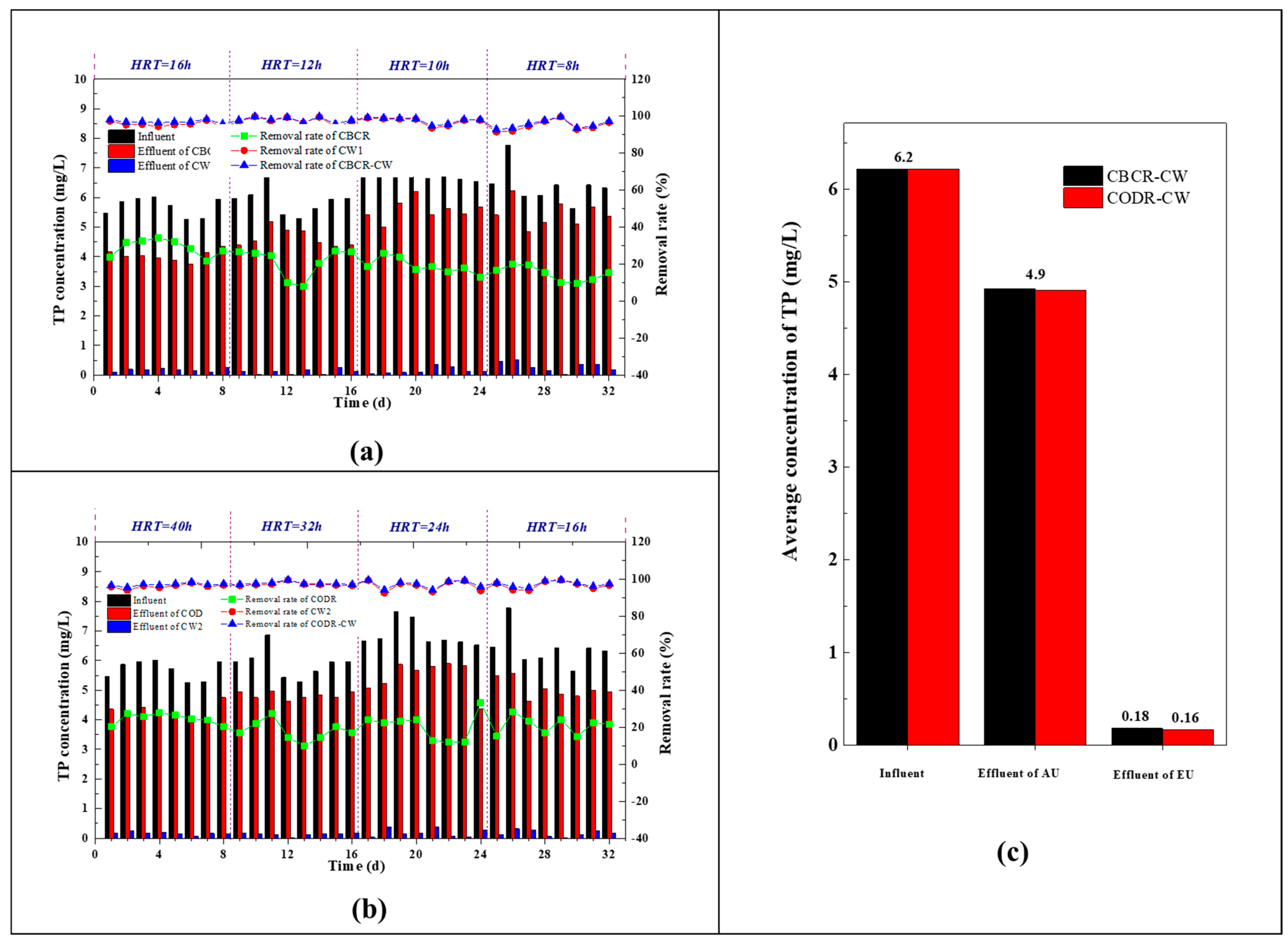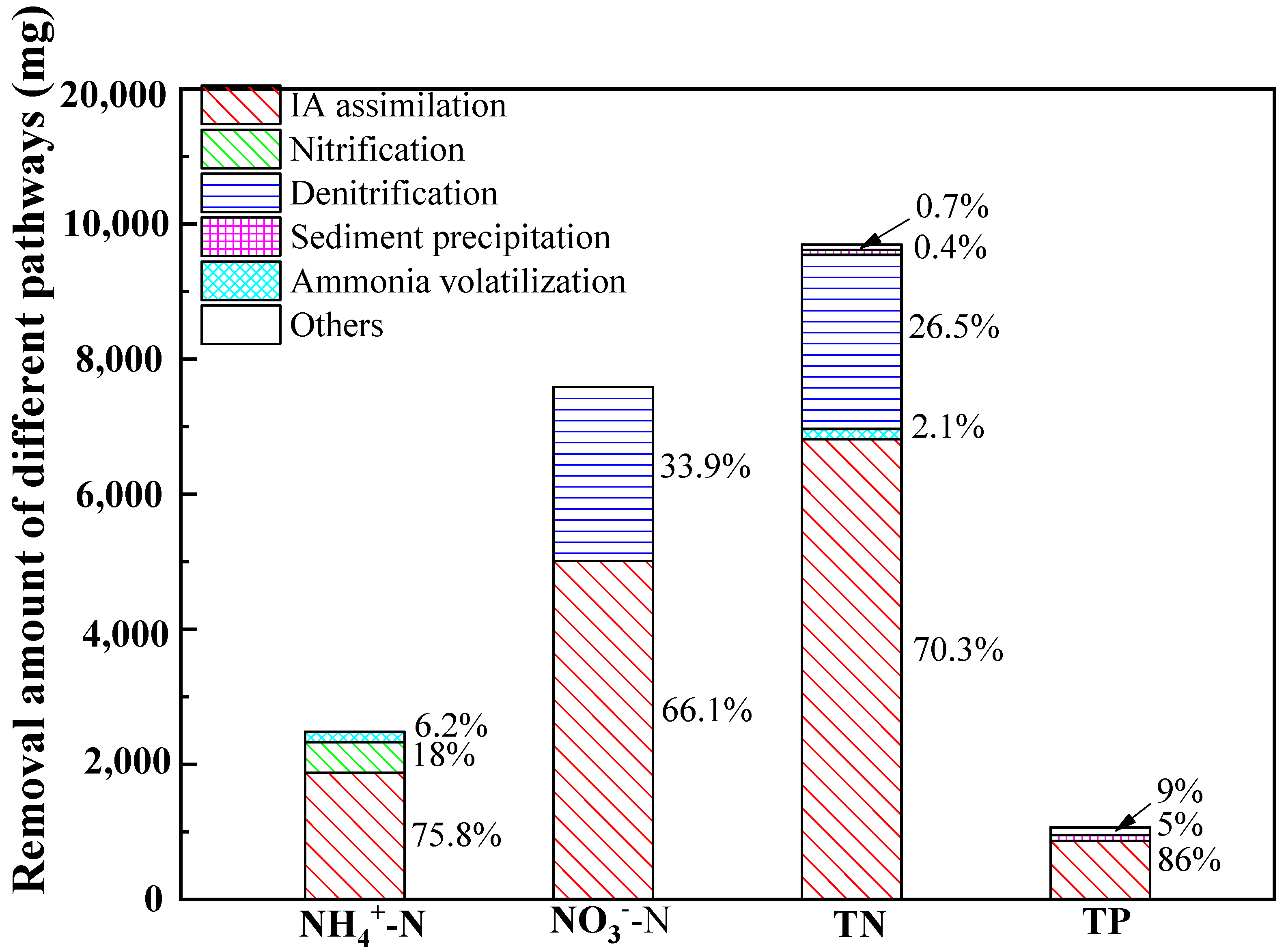Pathways of Nitrogen and Phosphorus Utilization and Removal from Cyanobacteria Wastewater by Combining Constructed Wetlands with Aerobic Reactors
Abstract
:1. Introduction
2. Experimental Setup and Methodology
2.1. Experimental Setups
2.1.1. AU Setups
- (1)
- CBCR design
- (2)
- CODR design
2.1.2. EU Setup
2.2. Experimental Methodology
2.2.1. Chemical Analysis
2.2.2. CW Methodology
- (1)
- Measurement of nitrification and denitrification intensity in the CW
- (2)
- Determination of IA absorption capacity for different forms of N and P
- (3)
- Calculation method of removal amount of different forms of nitrogen and phosphorus
3. Results and Discussions
3.1. Water Quality Characteristics Analysis of Anaerobic Biogas Slurry
3.2. Analysis of Removal Efficiency of Pollutants in AUEU
3.2.1. COD Removal Efficiency
3.2.2. NH4+-N Removal Efficiency
3.2.3. TN Removal Efficiency
3.2.4. TP Removal Efficiency
3.2.5. Removal of Algal Toxins from Biogas Slurry
3.3. Removal Mechanisms of Nitrogen and Phosphorus in Constructed Wetlands
3.3.1. The Nitrification and Denitrification Rates in Sediment
3.3.2. Effect of Plant Assimilation on the Removal and Utilization on Nitrogen and Phosphorus
3.3.3. Removal Mechanism of Nitrogen and Phosphorus
4. Conclusions
Author Contributions
Funding
Institutional Review Board Statement
Informed Consent Statement
Conflicts of Interest
References
- Sinha, E.; Michalak, A.M.; Balaji, V. Eutrophication will increase during the 21st century as a result of precipitation changes. Science 2017, 357, 405–408. [Google Scholar] [CrossRef] [PubMed] [Green Version]
- Viso-Vázquez, M.; Acuña-Alonso, C.; Rodríguez, J.; Álvarez, X. Remote detection of cyanobacterial blooms and chlorophyll-a analysis in a eutrophic reservoir using Sentinel-2. Sustainability 2021, 13, 8570. [Google Scholar] [CrossRef]
- Liu, L.; Huang, Q.; Qin, B.; Zhu, G.; Wu, P.; Wu, Y. Characterizing cell surface of blooming Microcystis in Lake Taihu, China. Water Sci. Technol. 2016, 73, 2731–2738. [Google Scholar] [CrossRef] [PubMed]
- Moreira, D.; Pires, J.C.M. Atmospheric CO2 capture by algae: Negative carbon dioxide emission path. Bioresour. Technol. 2016, 215, 371–379. [Google Scholar] [CrossRef] [PubMed]
- Krakat, N.; Demirel, B.; Anjum, R.; Dietz, D. Methods of ammonia removal in anaerobic digestion: A review. Water Sci. Technol. 2017, 76, 1925–1938. [Google Scholar] [CrossRef]
- Wang, Q.; Cao, H.; Yu, H.; Zhao, L.; Fan, J.; Wang, Y. Experimental Study on Purification Effect of Biochemical Pool Model for Treatment of Pavement Runoff by Aquatic Plants. Sustainability 2020, 12, 2428. [Google Scholar] [CrossRef] [Green Version]
- Postacchini, L.; Lamichhane, K.M.; Furukawa, D.; Babcock, R.W.; Ciarapica, F.E.; Cooney, M.J. Life cycle assessment comparison of activated sludge, trickling filter, and high-rate anaerobic-aerobic digestion (HRAAD). Water Sci. Technol. 2016, 73, 2353–2360. [Google Scholar] [CrossRef]
- Md Anawar, H.; Chowdhury, R. Remediation of polluted river water by biological, chemical, ecological and engineering processes. Sustainability 2020, 12, 7017. [Google Scholar] [CrossRef]
- Li, Y.; Manandhar, A.; Li, G.; Shah, A. Life cycle assessment of integrated solid state anaerobic digestion and composting for on-farm organic residues treatment. Waste Manag. 2018, 76, 294–305. [Google Scholar] [CrossRef]
- Chen, S.; Cao, Y.; Li, J. The effect of water rights trading policy on water resource utilization efficiency: Evidence from a quasi-natural experiment in China. Sustainability 2021, 13, 5281. [Google Scholar] [CrossRef]
- Neoh, C.H.; Noor, Z.Z.; Mutamim, N.S.A.; Lim, C.K. Green technology in wastewater treatment technologies: Integration of membrane bioreactor with various wastewater treatment systems. Chem. Eng. J. 2016, 283, 582–594. [Google Scholar] [CrossRef] [Green Version]
- Abdel-Shafy Hussein, I.; Al-Sulaiman, A.M.; Mansour Mona, S.M. Anaerobic/aerobic treatment of greywater via UASB and MBR for unrestricted reuse. Water Sci. Technol. 2014, 71, 630. [Google Scholar] [CrossRef]
- Showkat, U.; Najar, I.A. 2019 Study on the efficiency of sequential batch reactor (SBR)-based sewage treatment plant. Appl. Water Sci. 2019, 9, 2. [Google Scholar] [CrossRef] [Green Version]
- Masłoń, A. Impact of Uneven Flow Wastewater Distribution on the Technological Efficiency of a Sequencing Batch Reactor. Sustainability 2022, 14, 2405. [Google Scholar] [CrossRef]
- Yu, L.; Han, M.; He, F. A review of treating oily wastewater. Arab. J. Chem. 2017, 10, 1913–1922. [Google Scholar] [CrossRef] [Green Version]
- Duan, N.; Khoshnevisan, B.; Lin, C.; Liu, Z.; Liu, H. Life cycle assessment of anaerobic digestion of pig manure coupled with different digestate treatment technologies. Environ. Int. 2020, 137, 105522. [Google Scholar] [CrossRef]
- Ryu, B.G.; Kim, J.; Han, J.I.; Kim, K.; Kim, D.; Seo, B.-K.; Kang, C.-M.; Yang, J.-W. Evaluation of an electro-flotation-oxidation process for harvesting bio-flocculated algal biomass and simultaneous treatment of residual pollutants in coke wastewater following an algal-bacterial process. Algal Res. 2018, 31, 497–505. [Google Scholar] [CrossRef]
- Singh, N.K.; Kazmi, A.A.; Starkl, M. A review on full-scale decentralized wastewater treatment systems: Techno-economical approach. Water Sci. Technol. 2015, 71, 468–478. [Google Scholar] [CrossRef]
- Wu, H.; Zhang, J.; Ngo, H.H.; Guo, W.; Hu, Z.; Liang, S.; Fan, J.; Liu, H. A review on the sustainability of constructed wetlands for wastewater treatment: Design and operation. Bioresour. Technol. 2015, 175, 594–601. [Google Scholar] [CrossRef]
- Ávila, C.; Bayona, J.M.; Martín, I.; José Salas, J.; García, J. Emerging organic contaminant removal in a full-scale hybrid constructed wetland system for wastewater treatment and reuse. Ecol. Eng. 2015, 80, 108–116. [Google Scholar] [CrossRef] [Green Version]
- Radoux, M.; Cadelli, D.; Nemcova, M.; Ennabili, A.; Ezzahri, J.; Ater, M. Optimization of natural wastewater treatment technologies in the MHEA Experimental Centre in M’Diq, Mediterranean Coast of Morocco. In Proceedings of the Seventh International Conference on Wetland Systems for Water Pollution Control, Lake Buena Vista, FL, USA, 11–16 November 2000; pp. 1145–1152. [Google Scholar]
- White, S.A.; Cousins, M.M. Floating treatment wetland aided remediation of nitrogen and phosphorus from simulated stormwater runoff. Ecol. Eng. 2013, 61, 207–215. [Google Scholar] [CrossRef]
- Hubbard, R.K.; Newton, G.L.; Hill, G.M. Water quality and the grazing animal. J. Anim. Sci. 2004, 82, 255–263. [Google Scholar]
- Zhao, F.L.; Hu, G.D.; Wang, X.F.; Zhang, X.-H.; Yu, Z.-S. Serum overexpression of microRNA-10b in patients with bone metastatic primary breast cancer. J. Int. Med. Res. 2012, 40, 859–866. [Google Scholar] [CrossRef] [PubMed]
- Xian, Q.; Hu, L.; Chen, H.; Chang, Z.; Zou, H. Removal of nutrients and veterinary antibiotics from swine wastewater by a constructed macrophyte floating bed system. J. Environ. Manag. 2010, 91, 2657–2661. [Google Scholar] [CrossRef]
- Iglesias, A.; Rosenzweig, C.; Pereira, D. Agricultural impacts of climate change in Spain: Developing tools for a spatial analysis. Glob. Environ. Chang. 2000, 10, 69–80. [Google Scholar] [CrossRef]
- Dai, J.; Xu, M.; Chen, J.; Yang, X.; Ke, Z. PCDD/F, PAH and heavy metals in the sewage sludge from six wastewater treatment plants in Beijing, China. Chemosphere 2007, 66, 353–361. [Google Scholar] [CrossRef]
- Martin, M.; Gargallo, S.; Hernandez-Crespo, C.; Oliver, N. Phosphorus and nitrogen removal from tertiary treated urban wastewaters by a vertical flow constructed wetland. Ecol. Eng. 2013, 61, 34–42. [Google Scholar] [CrossRef]
- Brix, H. Do macrophytes play a role in constructed treatment wetlands? Water Sci. Technol. 1997, 35, 11–17. [Google Scholar] [CrossRef]








| Types of Test | Contents and Values | ||||||
|---|---|---|---|---|---|---|---|
| KH2PO4 | K2HPO4 | (NH4)2SO4 | KNO3 | Glucose | Volume Ratio | pH | |
| Nitrification | 0.2 mol/L | 0.2 mol/L | 0.05 mol/L | 0 mol/L | 0 mol/L | 3:7:30:0:0 | 7.2 |
| Denitrification | 0.2 mol/L | 0.2 mol/L | 0 mol/L | 0.03 mol/L | 0.02 mol/L | 3:7:0:30:10 | 7.2 |
| Type | Influent | Effluent of CODR | Effluent of CBCR | Effluent of CW2 | Effluent of W1 |
|---|---|---|---|---|---|
| TMC | 0.08 | 0 | 0 | 0 | 0 |
| EMC | 0.02 | 0 | 0 | 0 | 0 |
| TMC | 0 | 0 | 0 | 0 | 0 |
| EMC | 0 | 0 | 0 | 0 | 0 |
Publisher’s Note: MDPI stays neutral with regard to jurisdictional claims in published maps and institutional affiliations. |
© 2022 by the authors. Licensee MDPI, Basel, Switzerland. This article is an open access article distributed under the terms and conditions of the Creative Commons Attribution (CC BY) license (https://creativecommons.org/licenses/by/4.0/).
Share and Cite
Gong, L.; Zhao, X.; Zhu, G. Pathways of Nitrogen and Phosphorus Utilization and Removal from Cyanobacteria Wastewater by Combining Constructed Wetlands with Aerobic Reactors. Sustainability 2022, 14, 8819. https://doi.org/10.3390/su14148819
Gong L, Zhao X, Zhu G. Pathways of Nitrogen and Phosphorus Utilization and Removal from Cyanobacteria Wastewater by Combining Constructed Wetlands with Aerobic Reactors. Sustainability. 2022; 14(14):8819. https://doi.org/10.3390/su14148819
Chicago/Turabian StyleGong, Liying, Xuanxuan Zhao, and Guangcan Zhu. 2022. "Pathways of Nitrogen and Phosphorus Utilization and Removal from Cyanobacteria Wastewater by Combining Constructed Wetlands with Aerobic Reactors" Sustainability 14, no. 14: 8819. https://doi.org/10.3390/su14148819
APA StyleGong, L., Zhao, X., & Zhu, G. (2022). Pathways of Nitrogen and Phosphorus Utilization and Removal from Cyanobacteria Wastewater by Combining Constructed Wetlands with Aerobic Reactors. Sustainability, 14(14), 8819. https://doi.org/10.3390/su14148819






